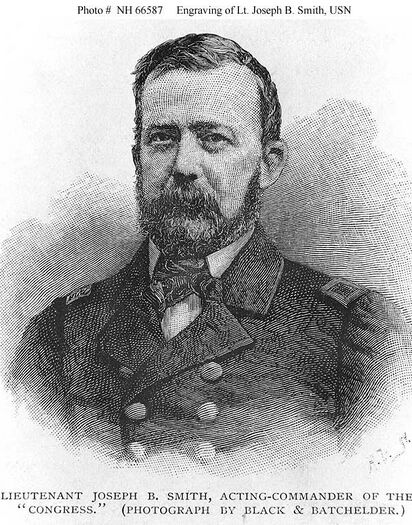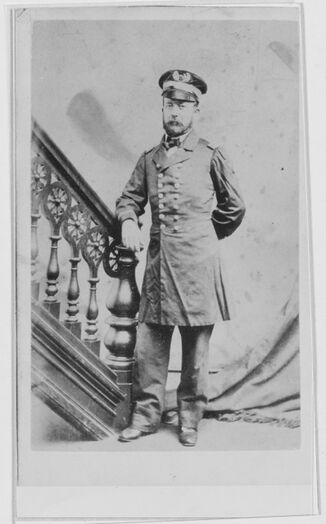JOSEPH B. SMITH, LT, USN
Joseph Smith '47
Loss
Joseph was killed in action with Confederate forces on March 8, 1862.
From Heroes of the United States Naval Academy:
On March 8, 1862, Lieutenant Smith was Executive Officer of USS Congress when he was killed defending his ship against the Confederate ironclad CSS Virginia (formally USS Merrimack). He previously served on the Merrimack before she fell into Confederate hands.
Joseph Bryant Smith was born in Belfast, Maine, on December 29, 1826 to Rear Admiral Joseph Smith USN and Mrs. Harriet (Bryant) Smith. He was appointed to the United States Navy in 1841. On October 19, 1841, he entered the Navy as a Midshipman. Later, he entered the Naval School in Annapolis Maryland at its founding in 1845. Midshipman Smith graduated 33 of 136 Midshipman from the United States Naval Academy on August 10, 1847.
Passed Midshipman Smith served at the Washington Navy Yard, in USS Mississippi and with the United States Coast Survey.
On August 22, 1855, Passed Midshipman Smith was promoted to Master.
On September 14, 1855, Master Smith was promoted to Lieutenant.
In 1857, Lieutenant Smith was assigned to the steam frigate USS Merrimack. Recommissioning September 1, 1857, Merrimack got underway from Boston Harbor on October 17, 1857 as flagship for the Pacific Squadron. She rounded Cape Horn and cruised the Pacific coast of South and Central America until heading for home November 14, 1859. Lieutenant Smith next had ordnance duty at the Washington Navy Yard, D.C.
In 1859, Lieutenant Smith joined USS Congress as First Lieutenant. Congress was reassigned as flagship of Commodore J. Sands and the Brazil Squadron, remaining in that area until the Civil War precipitated her return to Boston on August 22, 1861.
On September 9, 1861, she was ordered to duty under command of Captain Goldsborough in the Atlantic Blockading Squadron, later to serve under Commander W. Smith, and now Executive Officer Lieutenant Smith.
On January 13, 1862, Colonel D.W. Wardrop and his company “D” Union Coast Guard, Ninety-ninth Regiment, New York State Volunteers were assigned to the USS Congress. Congress that same day paid and discharged over 300 of her crew. The Army took over and practiced on the big guns. The Congress’ remaining officers and men were about two hundred and seventy.
On March 8, 1862, Congress was anchored off Newport News, Virginia, when she fell under attack by the Confederate ironclad, CSS Virginia (former USS Merrimack) and five other small ships. Lieutenant Smith was in charge of the ship during the Commanding Officer's absence when she was attacked and destroyed by ironclad Virginia. After the Virginia steamed out to attack the Union Navy ships that were blockading the James River, it destroyed the USS Cumberland before setting its sights on the Congress. Lieutenant Smith was acting commander of the vessel that day, and directed the ships defense in the battle, which was a one-sided affair, as the cannon fire from the Congress bounced off the Virginia’s iron plated hull, while the Confederate ship’s fire tore the wooden warship apart.
At about 1330, the Virginia opened fire upon the Congress with her two bow guns as she passed up the James River and then gave Congress a broadside from her four guns as Congress replied with her starboard battery and stern guns.
The Virginia after going up the river just beyond the range of the Congress’ guns, turned towards the sloop of war USS Cumberland, lying eight hundred yards above the Congress. After firing many raking shots into the Cumberland, Virginia rammed the Cumberland; then drawing off a short distance the Virginia renewed fire and ran again into the Cumberland when the latter commenced sinking rapidly, and very soon rolled on her beam. During this time the Virginia occasionally sent a shot into the Congress. Only the Congress’ stern guns could be brought to bear on the Virginia.
As the Virginia was approaching the Cumberland, Lieutenant Smith could not get the ship to swing on her cable and decided to slip her anchor and attempted to set sail but in the shallow water she ran aground. The Virginia, having sunk the Cumberland, maneuvered into a raking (through the length of the ship) position of the Congress about 100 yards from her stern. She commenced a rapid and most destructive fire with shot and shells into the Congress, breaking the muzzle of one and dismounting the other of Congress’ stern guns.
After the Congress took great casualties, Lieutenant Smith continued to direct the fight until a piece of Confederate artillery decapitated him.
At that time Congress’ flag was ordered lowered. The Confederate’s continued fire upon the Congress, so a white flag of surrender was hoisted up the main mast. A Confederate tug CSS Beaufort came alongside. An officer boarded Congress and ordered the men ashore, said he would take officers and burn the ship, and seemed unwilling to wait for the wounded to be taken off.
Lieutenant Smith’s body was taken off the ship while Confederates were taking prisoners.
He is listed on the killed in action panel in the front of Memorial Hall. He is buried in Washington, D.C.
The Register of Alumni does not have a date of his loss.
Career
From the Naval History and Heritage Command:
Midshipman, 19 October, 1841. Passed Midshipman, 10 August, 1847. Master, 22 August, 1855. Lieutenant, 14 September, 1855. Killed in action between Congress and CSS Virginia (formerly USS Merrimack), 8 March, 1862.
Namesakes
USS Smith (Destroyer No. 17) and USS Smith (DD 378) were named for Joseph.
The "Register of Commissioned and Warrant Officers of the United States Navy and Marine Corps" was published annually from 1815 through at least the 1970s; it provided rank, command or station, and occasionally billet until the beginning of World War II when command/station was no longer included. Scanned copies were reviewed and data entered from the mid-1840s through 1922, when more-frequent Navy Directories were available.
The Navy Directory was a publication that provided information on the command, billet, and rank of every active and retired naval officer. Single editions have been found online from January 1915 and March 1918, and then from three to six editions per year from 1923 through 1940; the final edition is from April 1941.
The entries in both series of documents are sometimes cryptic and confusing. They are often inconsistent, even within an edition, with the name of commands; this is especially true for aviation squadrons in the 1920s and early 1930s.
Alumni listed at the same command may or may not have had significant interactions; they could have shared a stateroom or workspace, stood many hours of watch together… or, especially at the larger commands, they might not have known each other at all. The information provides the opportunity to draw connections that are otherwise invisible, though, and gives a fuller view of the professional experiences of these alumni in Memorial Hall.
September 1842
January 1843
October 1843
January 1846
January 1847
January 1848
January 1849
January 1850
January 1851
January 1852
January 1853
January 1855
January 1856
January 1857
January 1858
January 1860
September 1861
Memorial Hall Error
Joseph is listed as "Joseph B. Smith" on the killed in action panel in the front of Memorial Hall; this should include his middle name, Bryant.

The "category" links below lead to lists of related Honorees; use them to explore further the service and sacrifice of alumni in Memorial Hall.

